Keeping Your Transmitting Plant Up to Par
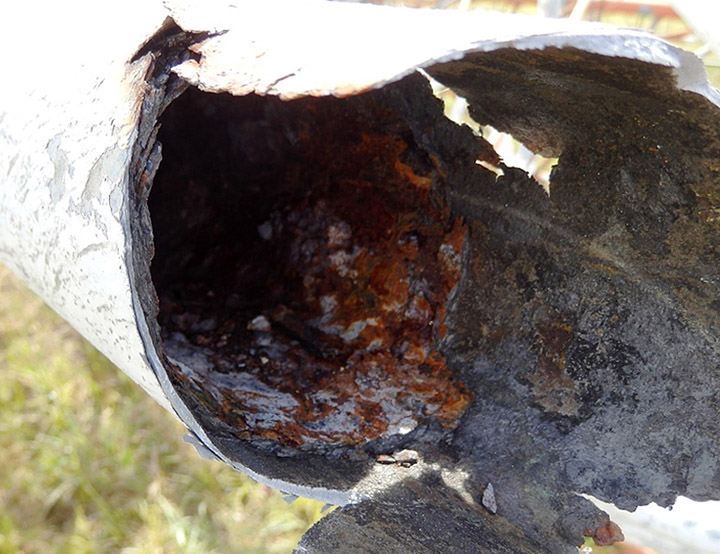
“Who knows what evil lurks inside some tubular tower members?” The owner of this tower found out the hard way that things on the inside are not always as they appear on the outside. (Photo credit: ERI)
ALEXANDRIA, Va.—In the “good old days,” a radio or television station’s transmitting facility received a lot of attention. Before the FCC relaxed its remote-control rules, larger radio plants and all television operations were staffed with on-site engineering personnel, and most remotely located (as in “mountaintop”) FM and TV transmitter plants were equipped with living quarters to ensure that someone would be there for sign-on during periods of bad weather.
There’s even one Washington, D.C.-area radio station that designed its new art deco transmitter building for public tours when it opened for business in the early 1940s. It had a receptionist, toilet facilities for both sexes and a large circular elevated catwalk for a 360-degree view of the giant Western Electric 50 kW transmitter located down below.
Unfortunately (or maybe fortunately as the “bean counters” view things), such niceties have all but disappeared due to the arrival of ultra-reliable transmitters, sophisticated remote control and monitoring systems, automation, and the ever-increasing demands for doing more with a constantly shrinking number of staff members.
The once well-oiled transmitting facilities of yore are just memories, and it’s an unfortunate fact of life now that today’s facilities don’t always get much attention unless something breaks. To make matters worse, only a vanishingly small number of stations have even one full-time transmitter engineer on staff. For at least a couple of decades now, it’s been common practice to use contract engineering help or, in group operations, to cycle “the transmitter guy” among multiple facilities.
With the widespread distribution of a station’s content via satellite and cable today and the shrinking of equipment profiles, perhaps transmitting facilities don’t command the respect they once did. However, at most broadcast operations the transmitter plant represents one of the largest, or perhaps the largest investment, so it really doesn’t pay to skimp on preventative maintenance.
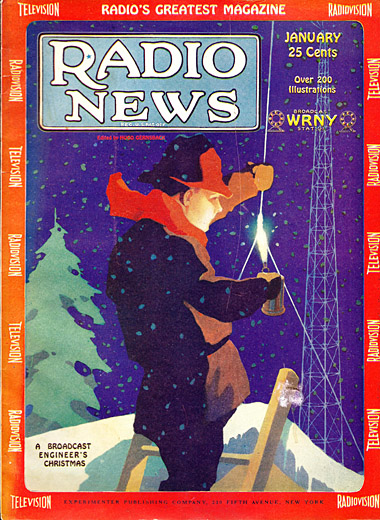
“Emergencies” at a broadcast transmitting plant are nothing new as evidenced by this Jan. 1929 magazine cover. It’s labeled “A Broadcast Engineer’s Christmas.”
Get the TV Tech Newsletter
The professional video industry's #1 source for news, trends and product and tech information. Sign up below.
Think too about continuity of operations in times of storm-related or other emergencies when there is no cable service and/or perhaps a break in the connectivity for feeding DirecTV or Dish Network. During such times it’s vitally important to be able to stay on the air to provide emergency information.
A little bit of preventive maintenance can go a long way in ensuring continuity of operations (and also some really big-ticket repairs).
WHAT YOU CAN’T SEE CAN STILL HURT YOU!
Smoke issuing from a transmitter cubicle or an out-of-plumb tower are very obvious indications that remediation is needed; however, according to several transmission professionals interviewed for this article, it’s the not-so-visible things that can bite the hardest.
According to Joe Burdette, vice president, co-founder and co-owner of United States Tower Services in Frederick, Md., buried guyline anchors are high on the list.
“Guy anchors can fail because you have copper ground rods bonded to galvanized anchor rods and the rods can corrode in damp soil or swampy conditions. The galvanized steel becomes a sacrificial element in the ‘battery’ that’s made up of the copper ground rod and the steel anchors,” said Burdette. “It’s always wise during an inspection to excavate all the way down to the concrete holding the guy anchor to look for any sign of corrosion. This is really essential in wet areas. I recall that at one installation I leaned up against an anchor rod and it just fell over. It had corroded completely away!”
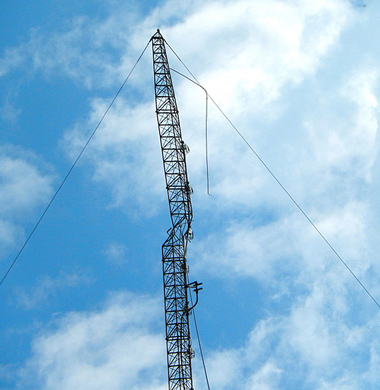
Hopefully you’ll never have to deal with a tower issue like this. Regular inspections and PM can help ward off what may become very expensive consequences later on. (Photo credit: ERI)
Tom Silliman, president and CEO of ERI (Electronics Research Inc.), echoed Burdette’s concerns about the subtle but devastating failure of guy anchors over time, and described the use of an inspection technique that doesn’t necessarily require excavation to determine anchor integrity.
“We have the capability of using time-domain reflectometry in the low frequency range to actually measure guy anchors to see if they have damage down underground,” said Silliman. “With this technology, you can ping the anchors to see if there’s damage just like you can look for a bad ‘bullet’ in a transmission line.”
Above-ground corrosion can also be extremely damaging in some tower installations, yet go unseen until it’s too late. Silliman noted that towers constructed with tubular members are especially prone to internal damage.
“If it’s a tubular leg structure, it can fail from the inside out,” he said. “One of the things you need to do [in inspecting] tubular leg towers is to verify that the ‘weep holes’ are still open. I’ve been to many towers where you walk up to the base and stick a little knife into the hole and all this rusty water comes out. That means that the tower is dead; it’s going to have to go.”
Silliman says that tube-leg towers really need to be inspected every two years, while a solid-leg tower can usually go for five years between inspections.
Burdette agreed that five years should be about the maximum time between inspections, but noted that newly erected towers should get special attention.
“An inspection the first year after it’s been put in is essential. Things are settling in and there may be bolts someone forgot to tighten or nuts that were dropped. There’s an infant mortality factor that you want to steer clear of.”

Tower fence or topiary? Only the station owner knows for sure. Tower workers shouldn’t have to come equipped with machetes or chain saws to change a burned-out beacon lamp.
Guy line tension is another item that should be part of a comprehensive tower inspection. Incorrect tensioning—unless it’s really extreme—is difficult to detect in a superficial examination, yet can cause tower failure.
“Guy wire ‘galloping’ can cause components to fail on the tower and breakage of guy line brackets,” said Silliman. “If a wire is not tensioned properly—say it’s at six percent instead of the 11 percent it was designed for, it can start flying around and bouncing with high winds. This is amplified by icy conditions; the ice can form a sort of airplane wing effect [and exacerbates movement in the wind]. When you see this it’s really incredible; just god-awful scary.”
Both Silliman and Burdette advise stations to choose their tower maintenance and erection crews carefully.
“You want to verify that everybody on the crew has had climbing training and rescue training,” said Silliman. “You also want to verify that they have proper equipment. You need ask for and to check references. The way OSHA operates now is that if you have a crew that’s working without proper equipment or safety training you can get cited along with the crew.”
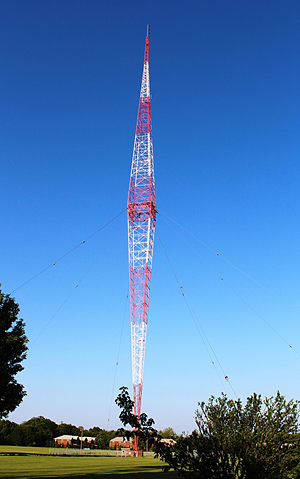
WLW’s iconic Blaw-Knox “diamond” radio tower was erected more than 80 years ago, is still in use, and just as sturdy as when the last fastener went in, illustrating that with a little “TLC,” there’s no preordained end-of-life date for a well-maintained broadcast tower.
HOW LONG SHOULD YOUR TOWER LAST?
“If it’s a self-supporting tower that’s galvanized and well maintained, technically it could last forever,” said Silliman. “If it’s a solid leg tower and guyed and well designed, then it’s just a matter of maintaining the guy lines. They do have to be replaced from time to time.”
Silliman noted that tower design standards have evolved over the years and did suggest checking station or manufacturer documentation in connection with older “sticks.”
“Your biggest concern is with towers designed under the ‘C’ standard or before,” said Silliman. “The standards have continually improved.”
He explained that the “C” standard didn’t recognize the fact that towers installed on the edge of a mountain crest in cold locations are special cases, citing some towers that were built to standard but failed anyway. In such instances winds can accelerate up the side of the mountain and over-stress the structure, especially when it’s carrying a heavy load of ice. The latest design standard takes such cases into consideration.
However, special environments notwithstanding, a well built and maintained tower is a one-time investment and doesn’t really have to be replaced at some predetermined interval.
“Look at the Eiffel Tower,” said Burdette. “It’s been up for well over 100 years. If you’ve got a tower that’s been up for 50 years of so, it’s seen everything,” said Burdette. “It’s very unlikely that it’s too [antiquated] to stand.”
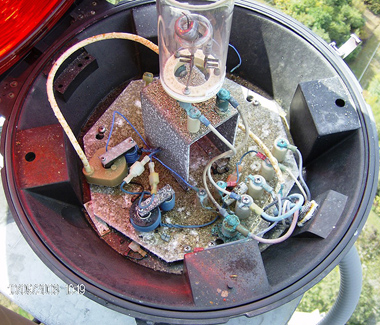
The water damage to this tower beacon is obvious; a little preventative maintenance could have meant the difference between a long useful life and a costly replacement job. (Photo courtesy of U.S. Tower Services)
TOWER LIGHTING INTO THE 21ST CENTURY
High-intensity LEDs have made large inroads in terms of replacing conventional electric lights during the past decade or so due to their many positive features. This applies to broadcast tower lighting systems too. If you haven’t given much thought to replacing existing tower lights with this new technology, maybe now is the time to do so.
“Even the AMs who don’t have a lot of money are going to LEDs because when they hear that we have to charge them many hundreds of dollars to re-lamp a tower, this is a significant portion of a new lighting system,” said Burdette. “We can put in relatively cheap LEDs and then we don’t have to go back for five or 10 years. The labor to go up and re-lamp an incandescent tower is getting higher and higher.”
He also mentioned the savings in electricity gained by retrofitting incandescent beacons and side lights with LEDs is another factor nudging tower owners to budget money for this.
“You can have an [annual] electric bill running into thousands of dollars for a tall tower,” said Burdette. “[After a while] you start to bite into the cost of the new equipment. Electricity is not free and you don’t have to call us every six months to a year-and-a-half to change bulbs.”
YOU DON’T WANT THIS KIND OF ‘GREEN’
In discussing tower maintenance, Burdette mentioned that facility owners should also stay on top of “grounds” maintenance—not the electrode variety, but rather what’s growing up around the tower and its guy lines. Not only does an overgrowth of vegetation hinder access to the tower base and guy anchors, it can hide some critters that tower crews may not want to encounter (aggressive four-footed animals and snakes—poisonous and otherwise) and could indirectly be responsible failure of a tower.
A falling tree near a guy run is also a potential hazard.
“Most customers realize when they see a rotten tree leaning over their guy wires it’s a big risk,” said Burdette. “It’s hard to break an inch-in-diameter guy wire on a tall tower; however, a little AM’s [tower guy lines] could be much more vulnerable. Owners need to keep their guy lanes open and free of scary looking big trees.”
An overgrowth of shrubs, tall weeds, trees, or piles of cleared brush can also pose a special hazard at some tower sites.
“It’s not wise to have a lot of vegetation around anchors—especially those with ‘potted sockets,’” cautioned Burdette. “The potting of those sockets with those big guy wires is typically zinc or some other low [melting] temperature metal that they pour in there to keep the wires in the tapered sockets. If you have a brush fire they can melt and the tower can fall over.”
So, nothing has really changed in the more than 250 years when Benjamin Franklin offered that “an ounce of prevention is worth a pound of cure.” Maintaining reliability is still all about staying on top of things.
The second installment of this article will go inside the transmitter building to flag potential issues and offer preventive maintenance tips to ensure full continuity of operation for broadcasters.
James O’Neal is a retired broadcast engineer with more than 35 years of experience in the field. For the past 10 years he has served as technology editor at TV Technology magazine.
